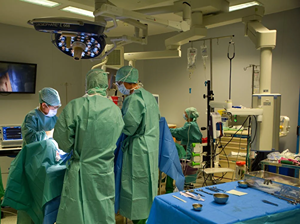Introduction
In the modern landscape of healthcare, surgical procedures play a critical role in saving lives and improving the quality of life for countless individuals. However, despite advancements in medical science, surgical errors still pose a significant risk to patient safety. In fact, studies suggest that surgical errors contribute to a notable percentage of adverse outcomes in surgeries. This raises an important question: how can technology help mitigate these risks? Enter the realm of innovative technology—where robotics, artificial intelligence (AI), and enhanced imaging techniques are transforming the surgical experience. Let’s dive deep into The Role of Technology in Reducing Surgical Errors.
Understanding Surgical Errors
What Are Surgical Errors?
Surgical errors refer to mistakes made during surgical procedures that can lead to serious complications or even death. These errors can range from wrong-site surgeries to anesthesia mishaps and miscommunication among the surgical team.
Common Types of Surgical Errors
Wrong-Site Surgery: A surgeon operates on the incorrect body part. Retained Surgical Items: Instruments or sponges left inside the patient post-operation. Anesthesia Errors: Issues arising from incorrect dosages or monitoring. Inadequate Communication: Misunderstandings among surgical staff.Statistics on Surgical Errors
According to recent studies, approximately 3,000 to 4,000 surgical errors occur annually in the United States alone. This statistic highlights an urgent need for comprehensive solutions to reduce these occurrences.
The Role of Technology in Reducing Surgical Errors
Technology has become a game changer in minimizing surgical errors. By integrating cutting-edge tools and systems into surgical practices, healthcare professionals can enhance precision and communication throughout the process.
How Robotics Enhance Precision
Robotic-Assisted Surgery
Robotics have revolutionized minimally invasive surgery by providing surgeons with enhanced dexterity and precision. For instance, systems like the Da Vinci Surgical System allow surgeons to perform delicate procedures through small incisions with greater control than traditional methods.
- Benefits: Reduced recovery time Less postoperative pain Decreased risk of infection
Case Studies on Robotic Surgery
Numerous studies have shown that robotic-assisted surgeries result in fewer complications compared to traditional surgeries. For example, a study published in JAMA Surgery found that robotic prostatectomies had significantly lower rates of complications when compared to open surgeries.
The Impact of Artificial Intelligence
AI in Preoperative Planning
Artificial Intelligence can analyze vast amounts of data from previous surgeries, helping surgeons make informed decisions about complex cases before entering the operating room.
- Predictive Analytics: AI algorithms can predict potential complications based on patient history.
AI-driven Imaging Technologies
Innovative imaging technologies powered by AI allow for better visualization during surgery. Techniques such as augmented reality (AR) provide surgeons with real-time overlays of critical structures within the human body.
- Enhanced Visualization: Improved mapping of anatomical structures Reduced chances of misidentifying tissues
Advanced Imaging Techniques
3D Imaging Technologies
3D imaging creates a detailed model of a patient's anatomy, allowing for meticulous preoperative planning.
- Applications: Complex reconstructions Tumor removals
Intraoperative Imaging
Real-time imaging during surgery helps surgeons visualize their progress and make necessary adjustments instantly.
- Benefits include: Immediate feedback Increased accuracy
Communication Technologies
Importance Of Effective Communication In The OR
Miscommunication is often cited as a leading cause of surgical errors. Effective communication among team members is essential for patient safety.
Digital Checklists And Protocols
Implementing digital checklists ensures all protocol steps are followed before, during, and after surgery.
- Benefits include: Standardizing procedures Minimizing human error
Team Collaboration Tools
Technologies like secure messaging apps enable rapid communication between team members during surgeries, ensuring everyone is on the same page.
Training & Simulation Technologies
Virtual Reality Training
Surgeons can practice complex procedures through virtual reality environments which simulate real-life scenarios without risking patient safety.
- Advantages: Enhanced skills development Reduced anxiety before actual procedures
Simulation-Based Learning
High-fidelity simulations allow for hands-on practice where trainees can learn from their mistakes without consequences in real life.
- Key Takeaways: Improves confidence Builds teamwork skills
Regulatory Standards & Compliance
The Role Of Regulatory Bodies
Organizations like The Joint Commission set standards that healthcare facilities must adhere to when implementing new technologies aimed at reducing errors.
Compliance With Technological Advancements
Healthcare providers must stay updated with regulatory changes regarding new technologies in order to maintain compliance while striving for excellence in patient safety.
Future Trends In Technology And Surgery
Predictive Analytics And Machine Learning
As machine learning continues evolving, it will likely play an even larger role in anticipating outcomes based on historical data from previous surgeries.
Remote Surgery Capabilities
Telemedicine is paving the way for remote https://www.moseleycollins.com/dana-point-ca-medical-malpractice-lawyer-hospital-negligence.html surgeries where specialists can guide local teams using advanced imaging technologies and robotic tools.
FAQs About Technology's Role In Reducing Surgical Errors
What types of technology are most effective at reducing surgical errors?
Robotics and AI-driven imaging technologies are some of the most effective tools currently available.
How does AI improve preoperative planning?
AI analyzes past data to predict potential complications and inform decision-making.
What is the significance of communication technology during surgery?
It facilitates real-time collaboration among team members, minimizing risks associated with miscommunication.

Can virtual reality training really enhance surgeon skills?
Yes! VR allows surgeons to practice intricate procedures safely before entering an actual operating room.

What role do regulatory bodies play regarding new technologies?

They establish guidelines that healthcare providers must follow when adopting new tech solutions.
How might future advancements change surgery practices further?
Innovations like remote surgery capabilities will expand access to specialized care regardless of location.
Conclusion
Technology’s role in reducing surgical errors cannot be overstated; it has become an essential ally for healthcare professionals striving for improved patient outcomes. From robotics enhancing precision to advanced imaging techniques that provide unparalleled insight into human anatomy, each advancement brings us closer to minimizing risk during surgeries. As we look toward future innovations—such as remote surgery capabilities—the potential benefits seem limitless. By embracing these technological advancements wholeheartedly, we can create safer operating rooms that ultimately save lives and foster trust between patients and healthcare providers alike.
Thank you for reading this extensive article on "The Role of Technology in Reducing Surgical Errors." If you have any questions or comments about this topic or want more information about specific technologies discussed here, feel free to reach out!